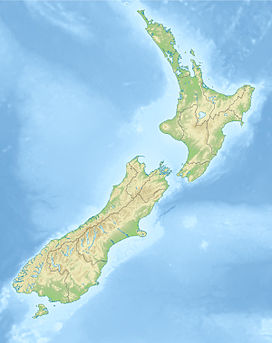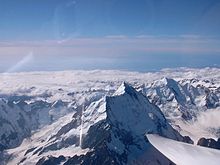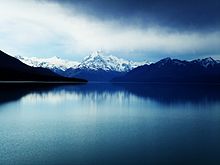- Aoraki / Mount Cook
-
"Mount Cook" redirects here. For other uses, see Mount Cook (disambiguation)."Aoraki" redirects here. For the Parliamentary electorate, see Aoraki (New Zealand electorate)."Aorangi" redirects here. For the island, see Poor Knights Islands.
Aoraki / Mount Cook Elevation 3,754 m (12,316 ft) [1] Prominence 3,754 m (12,316 ft)
Ranked 37thListing Country high point
UltraLocation South Island,  New Zealand
New ZealandRange Southern Alps Coordinates 43°35′44.69″S 170°8′27.75″E / 43.5957472°S 170.1410417°ECoordinates: 43°35′44.69″S 170°8′27.75″E / 43.5957472°S 170.1410417°E Climbing First ascent 1894 by Tom Fyfe, George Graham, Jack Clarke Easiest route glacier/snow/ice climb Aoraki / Mount Cook is the highest mountain in New Zealand, reaching 3,754 metres (12,316 ft).[1] It lies in the Southern Alps, the mountain range which runs the length of the South Island. A popular tourist destination,[2] it is also a favourite challenge for mountain climbers. Aoraki / Mount Cook consists of three summits lying slightly south and east of the main divide, the Low Peak, Middle Peak and High Peak, with the Tasman Glacier to the east and the Hooker Glacier to the west.
Contents
Location
The mountain is in the Aoraki / Mount Cook National Park, which was gazetted in 1953 and along with Westland National Park, Mount Aspiring National Park and Fiordland National Park forms one of the UNESCO World Heritage Sites. The park contains more than 140 peaks standing over 2,000 metres (6,600 ft) and 72 named glaciers, which cover 40 percent of the park's 700 square kilometres (170,000 acres).
The settlement of Mount Cook Village is a tourist centre and base camp for the mountain. It is 7 km from the end of the Tasman Glacier and 12 km south of Aoraki / Mount Cook's summit.
Naming and European discovery
Aoraki is the name of a person in the traditions of the Ngāi Tahu iwi; an early name for the South Island is Te Waka o Aoraki (Aoraki's Canoe). In the past many believed it meant "Cloud Piercer",[3] a romantic rendering of the name's components: ao (world, daytime, cloud, etc.) and raki or rangi (day, sky, weather, etc.).[4] Historically, the Māori name has been spelt Aorangi, using the standard Māori form.
While the mountain was known to Māori centuries before, the first European known to see Aoraki / Mount Cook was Abel Tasman,[3] on December 13, 1642 during his first Pacific voyage. The English name of Mount Cook was given to the mountain in 1851 by Captain John Lort Stokes[1] to honour Captain James Cook who first surveyed and circumnavigated the islands of New Zealand in 1770. Captain Cook did not sight the mountain during his exploration.[5]
Following the settlement between Ngāi Tahu and the Crown in 1998, the name of the mountain was officially changed from Mount Cook to Aoraki / Mount Cook to incorporate its historic Māori name, Aoraki.[6] As part of the settlement, a number of South Island placenames were amended to incorporate their original Māori name. Signifying the importance of Aoraki / Mount Cook, it is the only one of these names where the Māori name precedes the English. Under the settlement the Crown agreed to return title to Aoraki / Mount Cook to Ngāi Tahu, who would then formally gift it back to the nation.[6] Neither transfer has yet occurred; Ngai Tahu can decide when this will happen.[7]
Geology
The Southern Alps on the South Island were formed by tectonic uplifting and pressure as the Pacific and Indo-Australian Plates collided along the island's western coast. The uplifting continues, raising Aoraki / Mount Cook an average of 7 millimetres (0.28 in) each year. However, erosive forces are also powerful shapers of the mountains. The severe weather is due to the mountain's jutting into powerful westerly winds of the Roaring Forties which run around approximately 45°S latitude, south of both Africa and Australia. The Southern Alps are the first obstacle the winds encounter after South Africa and Australia, having moved east across the Southern Ocean.
The height of Aoraki / Mount Cook was established in 1881 by G. J. Roberts (from the west side) and in 1889 by T. N. Brodrick (from the Canterbury side). Their measurements agreed closely at 12,349 feet (3,764 m). The height was reduced by 10 metres (33 ft) when approximately 10 million cubic metres of rock and ice fell off the northern peak on 14 December 1991.[8][9]
Climbing history
The first recorded European attempt on the summit was made by the Irishman Rev. William S. Green and the Swiss hotelier Emil Boss and the Swiss mountain guide Ulrich Kaufmann on 2 March 1882 via the Tasman and Linda Glaciers.[10] Mt Cook Guidebook author Hugh Logan considers they reached within 50 metres of the true summit.[11]
The first ascent was on 25 December 1894, when New Zealanders Tom Fyfe, James (Jack) Clarke and George Graham successfully reached the summit via the Hooker Valley and the north ridge.[12] Despite an earlier failed attempt on 20 December, the local climbers were spurred on by their desire for the first ascent to be made by New Zealand mountaineers amid reports that an Englishman Edward FitzGerald had his eye on the summit.[13] The party reached the summit at approximately 1:30pm after bounding up the last leg of the mountain full of excitement at reaching the top.[14] The route they had successfully traversed was not repeated again until the 100th ascent over 60 years later in 1955.[13] Swiss guide Matthias Zurbriggen made the second ascent on 14 March 1895 from the Tasman Glacier side, via the ridge that now bears his name. This is credited as the first solo ascent, although Zurbriggen was accompanied part of the way up the ridge by J Adamson. After Zurbriggen's ascent it was another ten years before the mountain was climbed again. In February 1905 James Clarke with four others completed the third ascent following Zurbriggen's route. So Clarke therefore became the first person to do a repeat ascent.
The first woman to ascend the mountain was Freda du Faur, an Australian, on 3 December 1910. Local guide George Bannister, a descendant of Te Koeti Turanga of Ngāi Tahu, was the first Māori to successfully scale the peak in 1912.[15] A traverse of the three peaks was first accomplished in 1913 by Freda du Faur and guides Peter and Alex Graham.
Ed Hillary made his first ascent in January 1948. In February 1948 with Ruth Adams, Harry Ayres and Mick Sullivan, Hillary made the first ascent of the South Ridge to the Low Peak [16] In order to celebrate the life of Hillary the South Ridge was renamed as Hillary Ridge in August 2011.[17]
Māori history, legends and traditions
According to Māori legend, Aoraki was a young boy who, along with his three brothers, were the sons of Rakinui, the Sky Father. On their voyage around the Papatuanuku, the Earth Mother, their canoe became stranded on a reef and tilted. Aoraki and his brothers climbed onto the top side of their canoe. However, the south wind froze them and turned them to stone. Their canoe became the Te Waka o Aoraki, the South Island. Aoraki, the tallest, became the highest peak, and his brothers created the Kā Tiritiri o te Moana, the Southern Alps.[1][18][19][20]
The Ngāi Tahu, the main iwi (tribe) of New Zealand's southern region, consider Aoraki as the most sacred of the ancestors that they had descended from. Aoraki brings the iwi with its sense of community and purpose, and remains the physical form of Aoraki and the link between the worlds of the supernatural and nature.[1]
Forests and glaciers
The average annual rainfall in the surrounding lowlands is around 7.6 metres (300 in). This very high rainfall leads to temperate rain forests in the coastal lowlands and a reliable source of snow in the mountains to keep the glaciers flowing. These include the Tasman and Murchison Glaciers to the east of the mountain and the smaller Hooker and Mueller Glaciers to its south.
Area history
- 1642 - Aoraki sighted by Abel Tasman
- 1770 - Captain Cook named the Southern Alps
- 1851 - Captain Stokes of the survey ship HMS Acheron gave the name Mt Cook to Aoraki[1]
- 1884 - First Hermitage built under the direction of Frank Huddleson
- 1894 - First ascent of Aoraki/Mount Cook, on Christmas Day, by Jack Clarke, Tom Fyfe and George Graham
- 1910 - Freda du Faur became the first woman to climb Aoraki/Mount Cook
- 1911 - The vital swing bridge is built in the Hooker Valley
- 1913 - First ascents of the footstool and Mt Sefton made by Freda du Faur's climbing party
- 1913 - Hermitage first ravaged by floods in January, then destroyed beyond repair by floods two months later
- 1914 - First fatal accident, when three men caught in avalanche on Linda Glacier
- 1914 - Second Hermitage opened, on different site
- 1957 - Second Hermitage razed to the ground
- 1959 - First school opens, Aoraki Mt Cook School
- 1981 - Passenger flights begin by Mount Cook Airline, now part of Air New Zealand Link
- 1982 - Mark Inglis trapped in snow cave
- 1991 - Avalanche of 10 million cubic metres of snow and rock causes 10 metres to be lost off the top of Aoraki/Mount Cook[8][9]
- 1998 - The Ngāi Tahu Claims Settlement Act officially recognises the original name, renaming the mountain Aoraki/Mt Cook[6]
Transport
Access to the area nearby is usually by Mt Cook Road, along the western shore of Lake Pukaki. A small airfield is also nearby. Aoraki / Mount Cook will be the starting point of the Alps to Ocean Cycle Trail to Oamaru, the trail to be constructed in the following years after approval in 2010 by the New Zealand Cycle Trail project.
See also
References
- ^ a b c d e f "Aoraki/Mount Cook: Canterbury places to visit". Department of Conservation. http://www.doc.govt.nz/parks-and-recreation/national-parks/aoraki-mount-cook/. Retrieved 2007-05-08.
- ^ "Aoraki/Mount Cook National Park Management Plan 2004" (PDF). Department of Conservation. http://www.doc.govt.nz/upload/documents/about-doc/role/policies-and-plans/aoraki-mount-cook-np-management-plan-1.pdf. Retrieved 2007-05-09.
- ^ a b Te Maire Tau (2006-12-21). "Ngāi Tahu - Aoraki - Te Ara Encyclopedia of New Zealand". Ministry for Culture and Heritage / Te Manatū Taonga. http://www.teara.govt.nz/NewZealanders/MaoriNewZealanders/NgaiTahu/2/ENZ-Resources/Standard/1/en. Retrieved 2007-05-08.
- ^ Māori Dictionary Online
- ^ James Cook (1728-1779). "Captain Cook's Journal During the First Voyage Round the World". pp. Sunday, March 18, 1770. http://www.gutenberg.org/etext/8106. Retrieved 2007-05-09.
- ^ a b c "NZ Government Executive Ngai Tahu Settlement". New Zealand Government Executive. http://www.executive.govt.nz/96-99/minister/graham/ngai-tahu/content/sec3.htm. Retrieved 2007-05-08.
- ^ Claire Trevett, Tuhoe veto followed parks advice, New Zealand Herald, 18 May 2010.
- ^ a b Michael J. Crozier. "Mt Cook landslide". Te Ara - the Encyclopedia of New Zealand. http://www.teara.govt.nz/EarthSeaAndSky/NaturalHazardsAndDisasters/Landslides/2/ENZ-Resources/Standard/1/en. Retrieved 2007-05-03.
- ^ a b T. J. Chinn; M. J. McSaveney (1992). "Mount Aoraki (Mount Cook) rock avalanche". Tai Awatea - Knowledge Net (More of Te Papa online). http://tpo.tepapa.govt.nz/ViewTopicExhibitDetail.asp?ExhibitionID=0x000a4de2&ExhibitID=0x000a4ede&Language=English. Retrieved 2007-05-03.
- ^ Green, Reverend William Spotswood (1883). The High Alps of New Zealand, or A Trip to the Glaciers of The Antipodes with an Ascent of Mount Cook.
- ^ p 11, Logan, H. (1990) Great peaks of New Zealand, New Zealand Alpine Club, Wellington, and John McIndoe Limited, Dunedin, New Zealand, ISBN 0-86868-125-3.
- ^ Haynes, J. (1994) Piercing the Clouds. Tom Fyffe: First to climb Mt Cook. Hazard Press, New Zealand, ISBN 0-908790-64-3.
- ^ a b "Aoraki/Mt Cook". Te Ara Encyclopedia of New Zealand. http://www.teara.govt.nz/en/mountaineering/3#2. Retrieved 28 March 2010.
- ^ "Mountaineering - First Ascent Aoraki/Mt Cook". Te Ara Encyclopedia of New Zealand. http://www.teara.govt.nz/en/mountaineering/3/4. Retrieved 28 March 2011.
- ^ Mountaineering - Guided climbing - Te Ara Encyclopedia of New Zealand
- ^ Sir Edmund Hillary, View from the Summit, p. 62, Pocket Books, New York, 1999, ISBN 0-7434-0067-4
- ^ "South Ridge of Mt Cook to be renamed Hillary Ridge". Radio New Zealand. 11 August 2011. http://www.radionz.co.nz/news/national/82214/south-ridge-of-mt-cook-to-be-renamed-hillary-ridge. Retrieved 10 August 2011.
- ^ "Aoraki/Mt Cook - History". New Zealand Tourism Guide. http://www.tourism.net.nz/new-zealand/about-new-zealand/regions/mt-cook-and-mackenzie-country/history.html. Retrieved 13 July 2010.
- ^ "Aoraki (Mt Cook) in the Southern Alps". Te Ara – The Encyclopedia of New Zealand. http://www.teara.govt.nz/en/ngai-tahu/2/1. Retrieved 13 July 2010.
- ^ "Aoraki/Mount Cook Education Resource" (PDF). Department of Conservation. 2010. p. 5. http://www.doc.govt.nz/upload/documents/getting-involved/students-and-teachers/field-trips-by-region/canterbury/aoraki/aoraki-mt-cook-education-resource-colour.pdf. Retrieved 14 July 2010.
External links
Towns of the Mackenzie District, Canterbury, New Zealand Towns Localities Allandale • Aoraki/Mount Cook • Ashwick Flat • Birch Hill • Black Forest • Camp Valley • Cannington • Cattle Valley • Chamberlain • Clayton • Cricklewood • Domain Corner • Eversley • Glentanner • Grays Hills • Haldon • Lake Ohau • Lake Pukaki • Lilybank • Limestone Valley • Mawaro • Middle Valley • Motukaika • Mount Nessing • Slip Panels Corner • Tekapo Military Camp • Trentham • Winscombe •
Categories:- Mountains of New Zealand
- Geography of the Canterbury Region
Wikimedia Foundation. 2010.







